Larger versions of most images are available from webmaster@solarsplash.com.
All photos on the site are protected by copyright law. If you want to use a photo that you find, contact webmaster@solarsplash.com for permission, and we will direct you to the owner of the photograph.
June 7 – 11, 2000
New Orleans, Louisiana
Sponsored by:
ASME Solar Energy Division, ASME Petroleum Division, the University of New Orleans, and others.
| 0 |  |
After 6 seasons in Wisconsin, the 2000 Splash was held at the University of New Orleans. Using Mardi Gras colors, the boat signs reflect the support given by the University and the Solar Energy and Petroleum Divisions of ASME. |
| 1 | 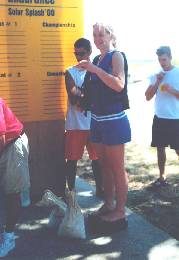 |
After completing Registration, each skipper is ballasted to 70 kg (154 lb) using small rocks in a sealed canvas bag. An identifying band is secured to the bag, the skipper’s wrist, and her/his life jacket. |
| 2 | 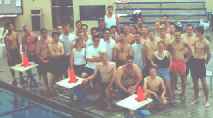 |
Before anyone is allowed on the water, each skipper must pass a mandatory swim test. All of the skippers assembled at the Aquatic Center and swam 50 meters at their own pace, but we did time them just for fun and to recognize some of the better performances. |
| 3 | 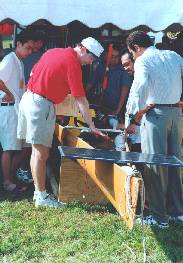 |
Technical inspections verify compliance with all rules. Many are written to provide maximum safety. The battery compartment must be separate from the skipper, and here we can see a white flexible hose that carries any vapors aft of the skipper once the bow is covered. |
| 4 | 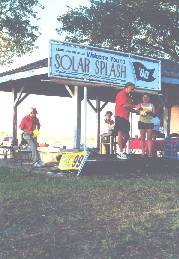 |
At the mixer Wednesday evening, team names are drawn from a hat for placement of the teams in the two heats of the Endurance Event. In that Event, all teams move into the Consolation or Championship rounds. |
| 5 | 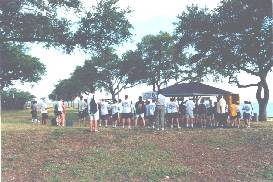 |
Each morning begins with an 8 a.m. Skippers meeting which is mandatory but also heavily attended by many team members. Plans for the day are reviewed and, often, awards from the previous day are presented. |
| 6 | 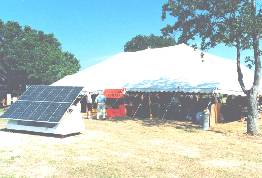 |
A large tent is provided to form the Paddock area and each team has an assigned space of 300 sq. ft. The area outside is often used to collect solar energy and recharge batteries. Some schools display their names and colors on banners. |
| 7 | 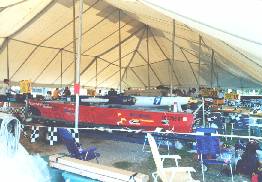 |
Many of the experienced teams bring chairs. Each team is provided a power drop to charge radio batteries or operate power tools. South Carolina really needed theirs as they lost one rudder and broke another, but with a third, borrowed from Coast Guard, they won the World Championship. |
| 8 | 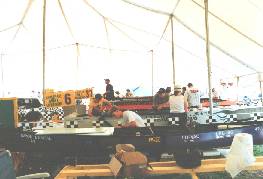 |
The LSU canoe underwent many changes over the course of the 5 days. With no deck, they found themselves vulnerable to waves and wakes so they added a temporary Styrofoam deck, got re-inspected, and went on to take 7th place in the Sprint. |
| 9 | 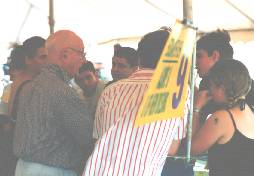 |
Numerous awards are presented for engineering accomplishments. Each team is interviewed to determine how they arrived at certain decisions that formed the design of the boat. Hull, power train, solar array, electrical system, and overall system engineering are reviewed. |
| 10 | 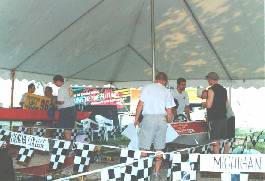 |
While the University of Arkansas discusses how to get more weight in the bow, there was no doubt that they were the winner of the “Hottest Looking Boat ” award. Outside the tent is the South Carolina trailer, beautifully painted and making its first appearance at the Splash. |
| 11 |  |
All boats operate on solar energy either received in real time or stored in their batteries. The teams are very diligent in taking advantage of all charging opportunities. Even a high thin overcast slows the process only slightly. |
| 12 | 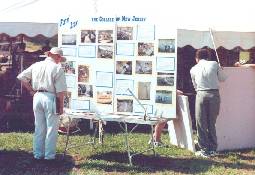 |
One of the events is a visual display of the project. It is important to show what cannot be seen by looking at the boat. This display by the College of New Jersey features components that were designed and tested but subsequently rejected. |
| 13 | 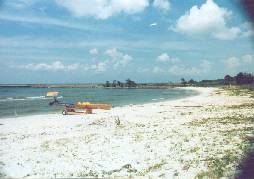 |
Unlike past years where man-made ramps were needed to launch the boats, Pontchartrain Beach provided excellent launching and plenty of warm water for wading. Teams were required to have relatively wide tires on their trailers and dollies to negotiate the soft sand. |
| 14 | 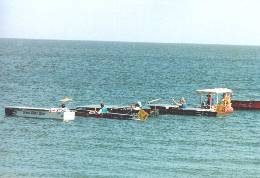 |
The sun was bright for the start of the first Endurance heat. A long overhead rope is provided for the skippers to use to hold their position on the starting line. The rope is raised just before the start. |
| 15 |  |
The course is a rectangle; so one lap is 750 meters. Here, #5 UNO is chasing Columbia. UNO’s hull is raised above the natural water line by forward and aft hydrofoils. They proved very effective and UNO placed second. |
| 16 | 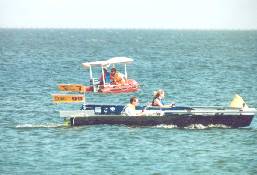 |
Kansas State University, using boat sign #99, passes the College of New Jersey at one of the corner marks. One of the two safety patrol boats can be seen in the background. A team of judges does lap counting in the same manner used for the Indy 500 for many years. |
| 17 | 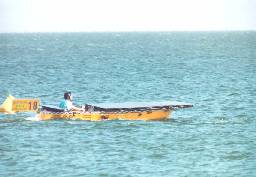 |
As Columbia rounds a mark, it appears that their automatic bilge pump is taking care of some excess water in the hull. One of the problems faced by most teams is that a thru hull drive shaft is the most efficient but results in the need for a “stuffing box”. |
| 18 | 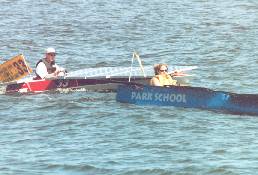 |
The weight distribution problems Arkansas had in the Sprint were minimized in the Endurance with slower speeds and the addition of the solar array. Many of the boats were so closely matched that this was not an unusual sight. |
| 19 | 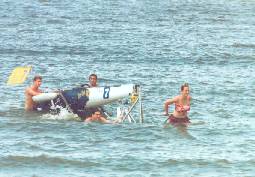 |
The “Flyin’ Lion” from New Jersey was designed to be on hydrofoils so it has a deep draft for the drive system. The result was the need to take the dolly into relatively deep water to load the boat, but the students didn’t seem to mind. |
| 20 | 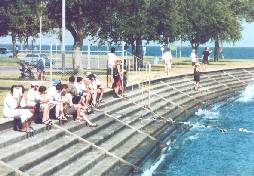 |
Students and visitors congregate along the sea wall to watch the events. With the courses laid out parallel to the wall, it was easy to see the activity. |
| 21 | 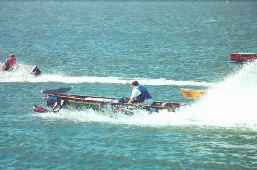 |
The final event was the Sprint on Sunday. Each team had a minimum of two runs. Here in the finals, Coast Guard has gotten off to a very fast start, but is having problems with the high torque of their drive system. The UNO boat takes a bit of time to get up to full speed and the USC bow is just visible on the right. |
| 22 | 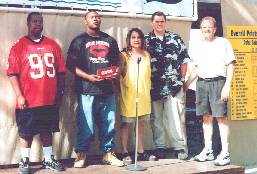 |
Everyone is a winner. Here, the Ottawa Hills Tech Prep High School team receives its award for Perseverance. They really hung in and got points in all events except the Slalom. |
| 23 | 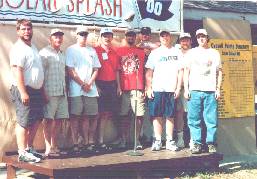 |
Although the trophy is a bit hard to spot, the University of Arkansas team did very well as the Best Rookie Team, Fourth Overall, First Place in the Solar Slalom and Second Place in Qualifying. |
| 24 |  |
This year, the Coast Guard Academy took Third Place Overall and again, was appreciated by everyone. Always willing to lend a hand to the organizers or other teams, they are respected and appreciated. |
| 25 | 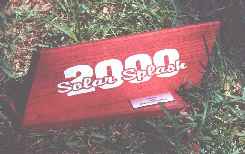 |
In keeping with the Mardi Gras theme, the trophies are make of Purple Heart wood which is laser etched with the 2000 logo and filled with silver. A total of 38 awards were presented during the Event this year. |